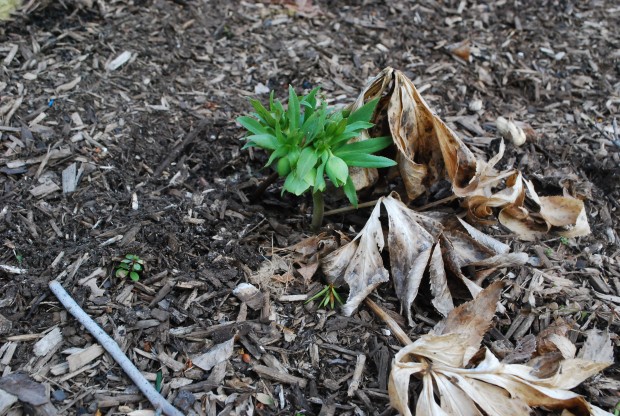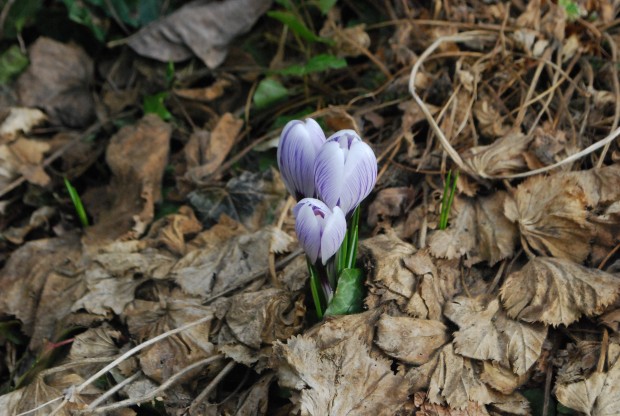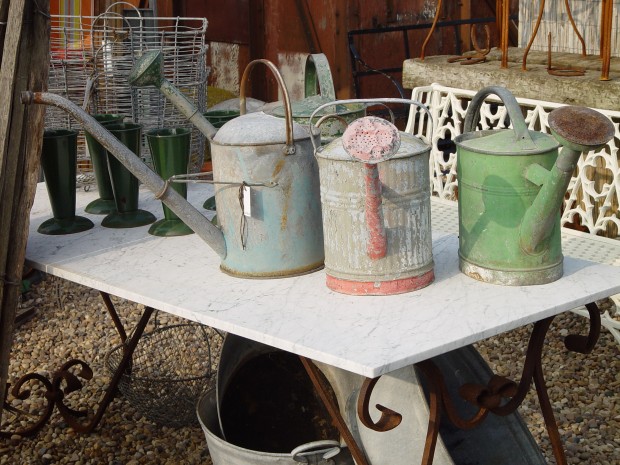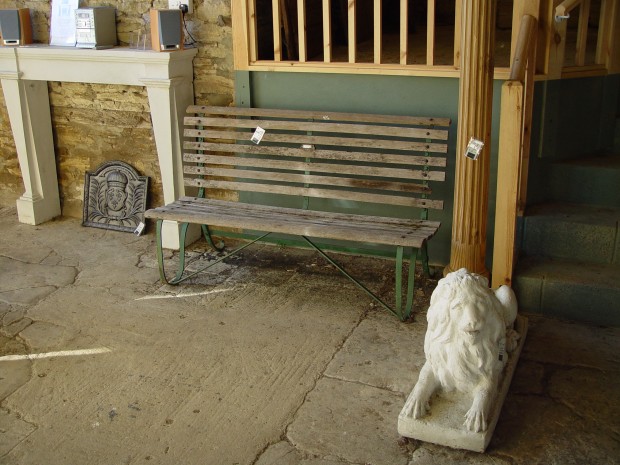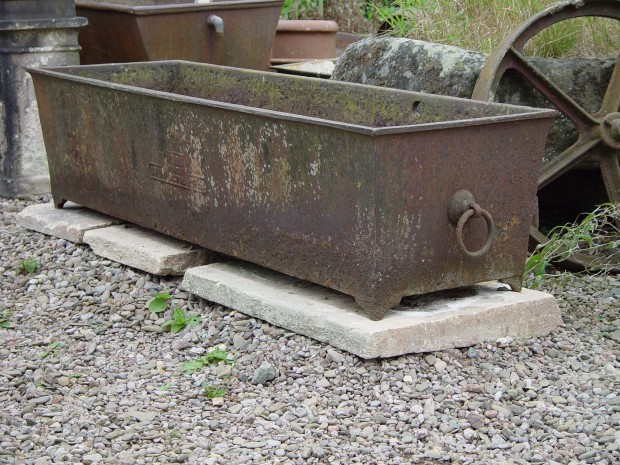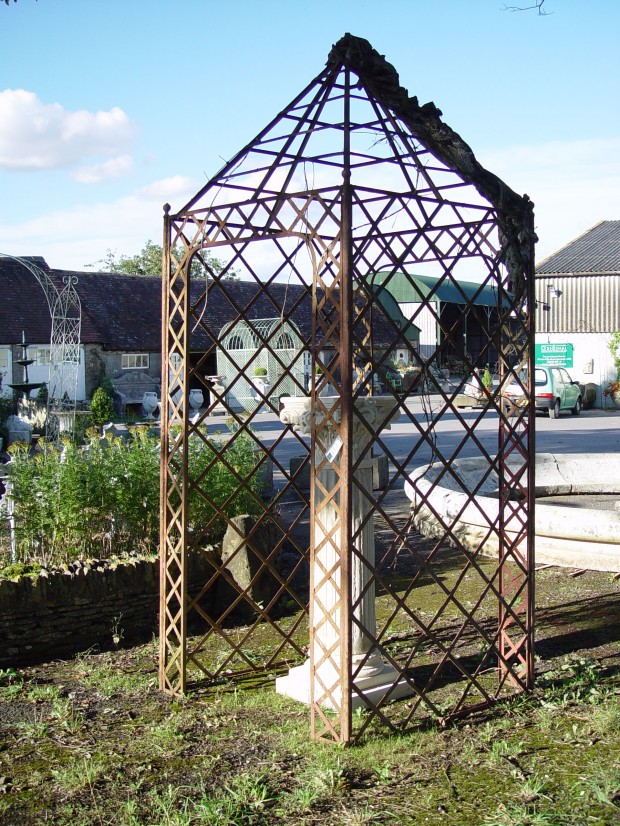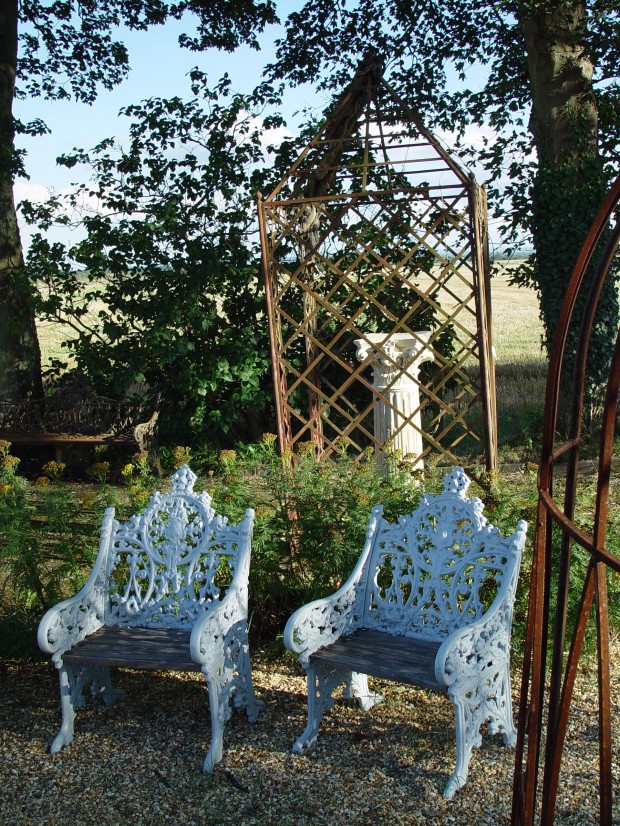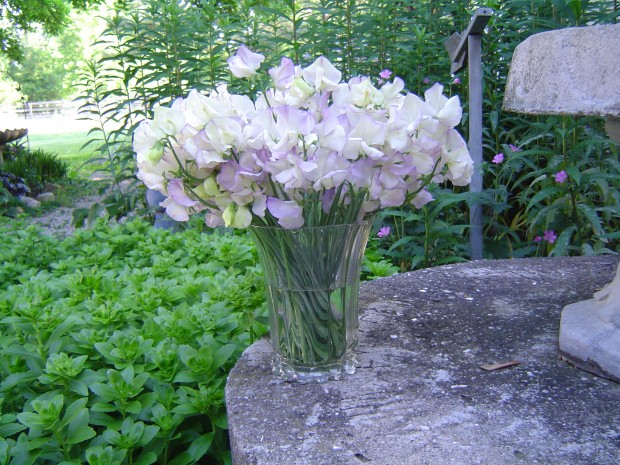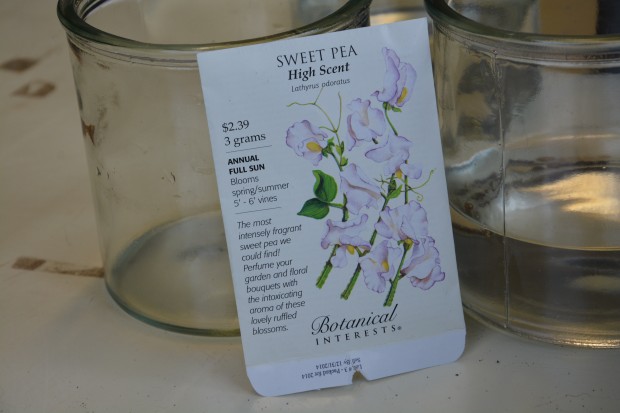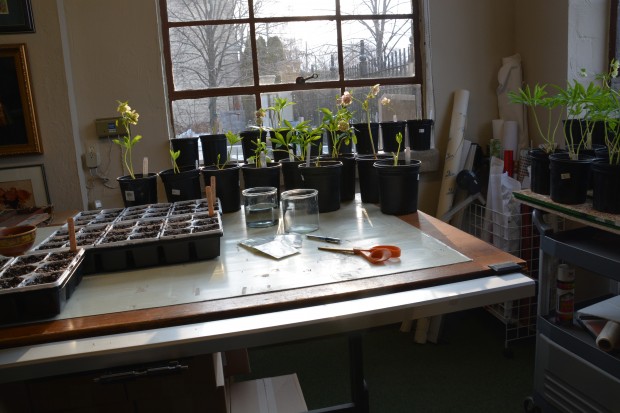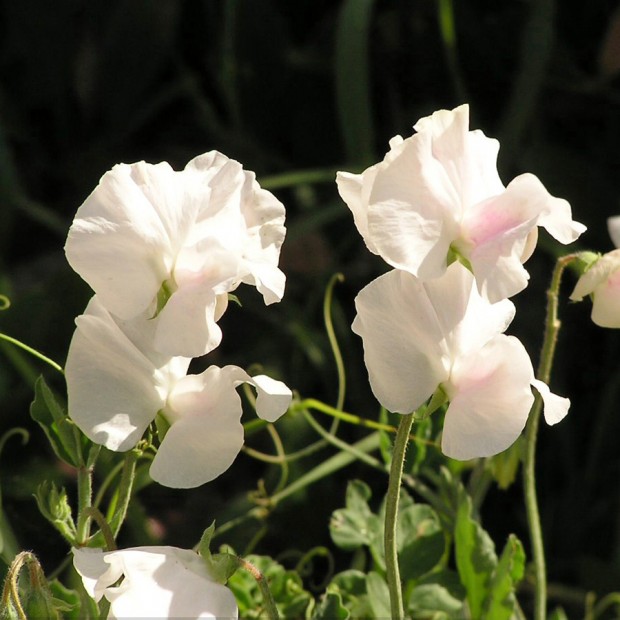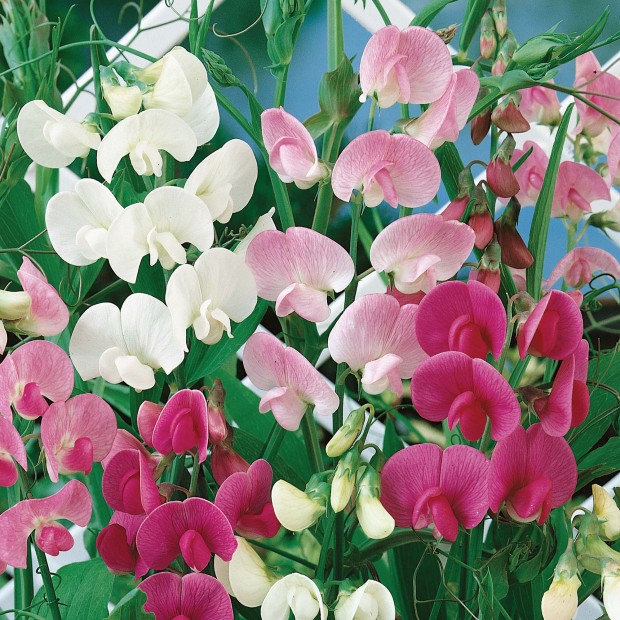
The leaves of trees and woody plants are solar cells that convert the energy from the sun into food that enables a plant to grow and sustain itself. This is a gardener talking-not a botanist. I observe that once a leaf is no longer able to perform its job, that leaf is shed from the plant. The fall is a very long process of abscission beginning in August, and ending once winter comes. Hellebores do not truly part company with their leaves until the spring following. Once the flower stalks push forth and bloom, then the hellebore concentrates its energy on new leaves. The leaves from last year pictured above-I am surprised they look as good as they do, considering this past winter. I will cut last years leaves off soon, so as not to disturb the flower stalks about to emerge. Hellebore foliage cares not one whit for abscission. They hold their leaves until the new season’s flowers are up and representing.
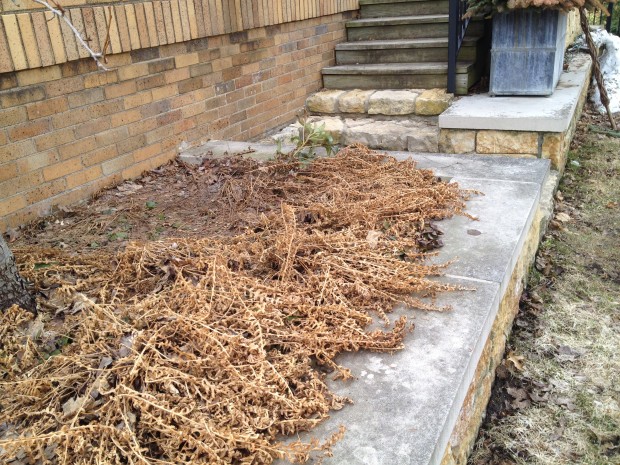 The mechanism by which deciduous plants shed their leaves is complex, and very interesting. Anything a plant no longer needs to survive, it sheds. Linden trees in water stress will shed their interior leaves in order to preserve the health of the tree. Yellow leaves on the interior of a deciduous tree could mean it is in stress from a lack of water. Fewer leaves needing water may help in a drought. Any tree needing water will shed any leaves it needs to, to preserve its life. The life central of a tree may direct that tree to shed unnecessary leaves. An evergreen tree in great and life threatening stress from environmental conditions may produce an incredible number of cones. Plants are engineered by nature to survive. Survival marks and engineers all of life. Gardeners one and all enjoy the process of fall color, and the dropping of leaves. Some trees, such as parrotia and beech, hang on to their leaves until the emergence of the new leaf buds in the spring push the previous years leaves off. My parrotias are still full of leaves, albeit brown leaves.
The mechanism by which deciduous plants shed their leaves is complex, and very interesting. Anything a plant no longer needs to survive, it sheds. Linden trees in water stress will shed their interior leaves in order to preserve the health of the tree. Yellow leaves on the interior of a deciduous tree could mean it is in stress from a lack of water. Fewer leaves needing water may help in a drought. Any tree needing water will shed any leaves it needs to, to preserve its life. The life central of a tree may direct that tree to shed unnecessary leaves. An evergreen tree in great and life threatening stress from environmental conditions may produce an incredible number of cones. Plants are engineered by nature to survive. Survival marks and engineers all of life. Gardeners one and all enjoy the process of fall color, and the dropping of leaves. Some trees, such as parrotia and beech, hang on to their leaves until the emergence of the new leaf buds in the spring push the previous years leaves off. My parrotias are still full of leaves, albeit brown leaves.
 I am not so anxious to remove the leaves and stalks from my perennials in the fall. I like the look of the snow on the remains of the garden. I also believe this detritus helps to shield and cushion my plants from fierce winter weather. I am content to let the garden go down in the fall, with every stalk and stem intact. I only do a spring cleanup. In the fall, every plant is shedding and covering its own. I don’t see the need to disturb that. Winter is a tough season. Our past winter was brutally cold and snowy. I am glad I left the garden be this past fall. The European ginger under this bench is virtually evergreen. It hangs on to its leaves with a vengeance. I never remove the old leaves; I leave them be. What I leave be in the garden eventually becomes compost. If you ever have the urge to clean up every leaf in the fall, think about the forest floor. The forest floor is a healthy and vibrant environment-just what you would want for your garden.
I am not so anxious to remove the leaves and stalks from my perennials in the fall. I like the look of the snow on the remains of the garden. I also believe this detritus helps to shield and cushion my plants from fierce winter weather. I am content to let the garden go down in the fall, with every stalk and stem intact. I only do a spring cleanup. In the fall, every plant is shedding and covering its own. I don’t see the need to disturb that. Winter is a tough season. Our past winter was brutally cold and snowy. I am glad I left the garden be this past fall. The European ginger under this bench is virtually evergreen. It hangs on to its leaves with a vengeance. I never remove the old leaves; I leave them be. What I leave be in the garden eventually becomes compost. If you ever have the urge to clean up every leaf in the fall, think about the forest floor. The forest floor is a healthy and vibrant environment-just what you would want for your garden.
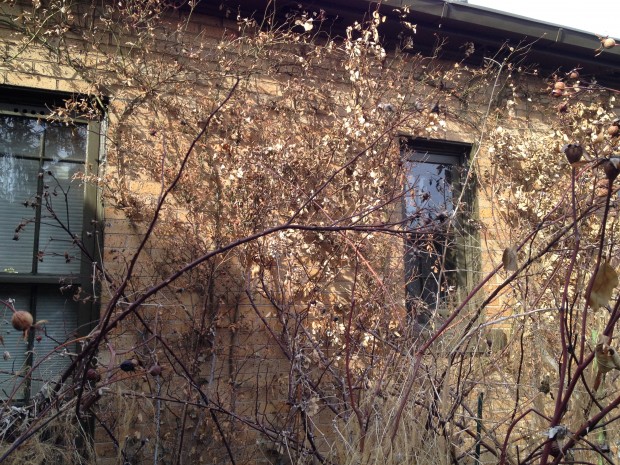 None of my roses shed their leaves this past fall. The leaves survived a terribly cold snowy and windy winter, intact. The leaves are still hanging on, this first week of April. We have only had temperatures above freezing for a few days. I cannot tell yet if my roses survived this winter.
None of my roses shed their leaves this past fall. The leaves survived a terribly cold snowy and windy winter, intact. The leaves are still hanging on, this first week of April. We have only had temperatures above freezing for a few days. I cannot tell yet if my roses survived this winter.
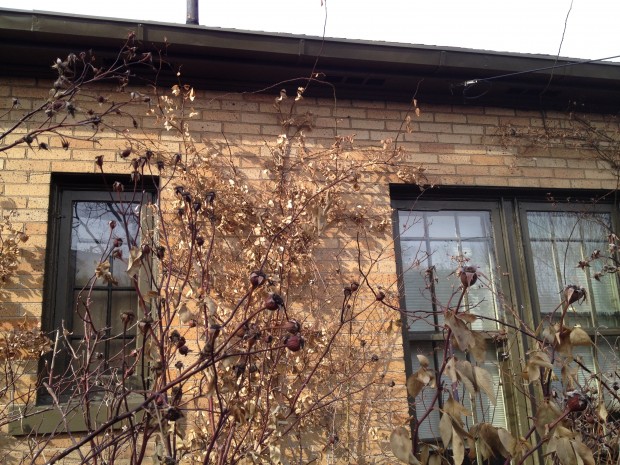 The leaves still attached to the roses-I have no idea what this means. I have seen lots of deciduous shrubs with the fall leaves still intact from last fall. Did the winter come to us so quickly that the process of the leaf drop was interrupted, detained?
The leaves still attached to the roses-I have no idea what this means. I have seen lots of deciduous shrubs with the fall leaves still intact from last fall. Did the winter come to us so quickly that the process of the leaf drop was interrupted, detained?
 Though nature can throw a mean and deadly curve ball when I am least expecting it, I know this spring could be just as tough as the winter we just experienced. I sat in the rose garden tonight for the first time since last October. Yes, I had on my hat and coat. I have no idea what is to come.
Though nature can throw a mean and deadly curve ball when I am least expecting it, I know this spring could be just as tough as the winter we just experienced. I sat in the rose garden tonight for the first time since last October. Yes, I had on my hat and coat. I have no idea what is to come.
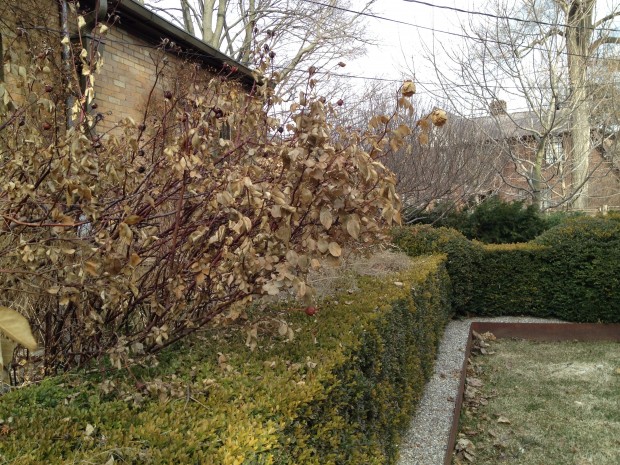 Should you have any idea why my roses never shed their leaves last fall, would you write me, please? I have never seen this. I do not know what to make of it. I am prepared for the worst. I am a gardener, first and foremost. Dealing with the worst in a garden is ordinary. Dealing with an unknown worst-keep me company, please.
Should you have any idea why my roses never shed their leaves last fall, would you write me, please? I have never seen this. I do not know what to make of it. I am prepared for the worst. I am a gardener, first and foremost. Dealing with the worst in a garden is ordinary. Dealing with an unknown worst-keep me company, please.

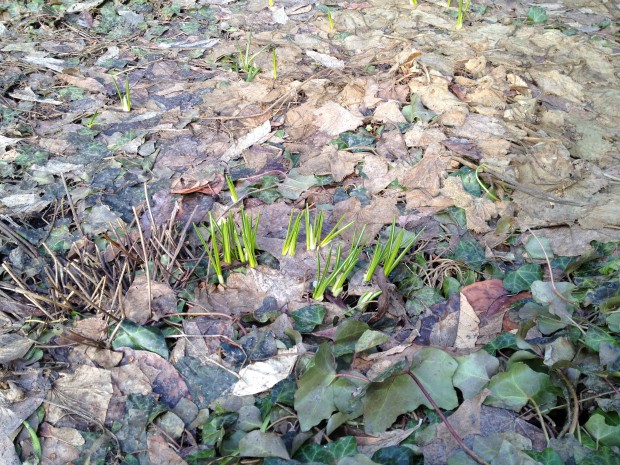
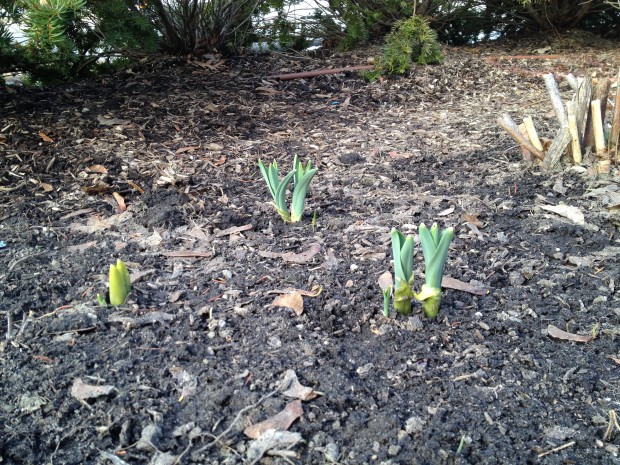

 Much of what I love about landscape design has to do with the notion of second chances. I have an idea. I put it to paper. I do the work of installing it. Then I wait for an answer back. It is my most important work-to be receptive to hearing what gets spoken back. The speeches come from everywhere-the design that could be better here and more finished there. The client, for whom something is not working well, chimes in. The weather, the placement and planting final exam test my knowledge and skill. The land whose form is beautiful but whose drainage is heinous teaches me a thing or two about good structure. The singing comes from everywhere. I make changes, and then more changes. I wait for this to grow in and that to mature. I stake up the arborvitae hedge gone over with ice, and know it will be two years or more-the recovery. I might take this out, or move it elsewhere. That evolution seems to have a clearly defined beginnings, and no end.
Much of what I love about landscape design has to do with the notion of second chances. I have an idea. I put it to paper. I do the work of installing it. Then I wait for an answer back. It is my most important work-to be receptive to hearing what gets spoken back. The speeches come from everywhere-the design that could be better here and more finished there. The client, for whom something is not working well, chimes in. The weather, the placement and planting final exam test my knowledge and skill. The land whose form is beautiful but whose drainage is heinous teaches me a thing or two about good structure. The singing comes from everywhere. I make changes, and then more changes. I wait for this to grow in and that to mature. I stake up the arborvitae hedge gone over with ice, and know it will be two years or more-the recovery. I might take this out, or move it elsewhere. That evolution seems to have a clearly defined beginnings, and no end.